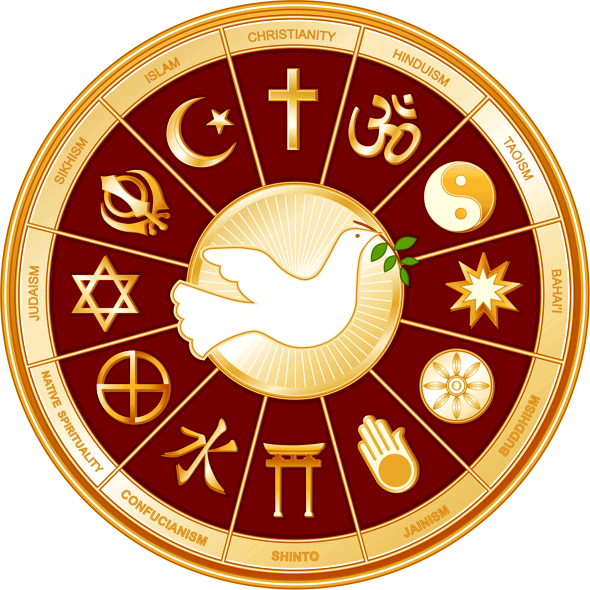Scholars, philosophers and religious teachers across the world have interpreted and described the nature and attributes of God in various names and forms in different cultures and religions for the time immemorial. In fact, the followers of two Abrahamic religions have even aggressively avowed and asserted in the modern age that ONE followed by them is the only true Almighty (God) and everything else is false. While visiting some Western countries, I have even noticed young boys and girls in groups at the intersections and city squares distributing religious pamphlets and aggressively trying to persuade visitors how only a particular prophet/messenger and god is the only truth and saviour of the world and mankind. At yet another extreme, some fanatic followers of another religion declare people of other faiths as kafir (sinner) and even openly argue about killing those who do not subscribe to their religion citing it as god’s edict.
Few years ago, I became curious about the ancient civilizations of the old and new worlds which thrived well with their culture and pantheon for thousands of years but were destroyed or lost with the advent of two new Abrahamic religions in the post Christ age. One common feature of nearly all these civilizations was their belief in polytheism and worship of the multiple gods, who basically represented forces of the natural phenomenon and elements. In effect, all natural forces and visible or invisible energies that affected human life in some way were deified by the ancient people either due to sheer reverence or insecurity and fear for own safety, well-being and prosperity. In a way, there is nothing wrong or objectionable if people conceptually or in practice acknowledge their gratitude through reverence or worship to all the visible and invisible “material and abstract forces and elements” that make human life convenient and comfortable in this world.

Today, I find that out of over a dozen significant ancient civilizations in various parts of the world, only the Sanatana Dharma (Hinduism) has survived in the modern age while most other ancient cultures and pantheons such as Sumer, Roman, Greek, Misr (Egypt), Persia, and so on, have become a thing of past i.e. completely or largely destroyed. This is also the reason why the world now recognizes Hinduism as the oldest surviving culture and religion. At the same time, certain elements and forces of the very same Neo-Abrahamic religions are constantly active against Hinduism with similar malaise and tactics that led to the fall of other ancient cultures and religions. Ironically and paradoxically, irrespective of their description of God and His messengers, something crucial and significant is always found amiss in their teaching and preaching leaving behind serious doubts and questions in the mind of rational and well-reasoned persons. But then such doubts and questions are scuttled by the edict of clerics that their faith (religion) does not allow any doubt, question or discussion among the subjects.
It is beyond comprehension and any logic or rationale why such an ALMIGHTY should prohibit His subjects application of mind and intellect decreeing followers to engage in coercion or evangelism to pressurize or incite people of other faiths to follow a particular creedal and dogmatic religion as it is now being done by certain organizations and people in a mission mode. In fact, when I find some clergy, scholars, politicians, and even professional scientists and technocrats in the neighbouring Islamic country (Pakistan) giving a call of Gazwa-e-Hind in a rhetorical tone, I find it quite frightening and insecure not only for the followers of the Hinduism in the Indian sub-continent but also for the entire mankind world over, wherever people cherish and value the ideals of the freedom of religion, culture, education, speech, equality, and so on.
When I analyze the ancient cultures, traditions and belief systems of some of the old world civilizations including the Sanatana Dharma, I find they had several elements of commonality among them about their socio-political and economic systems as well as religious faith. However, if one has to sum up their basic difference; a common trend emerges that while other civilizations had largely followed a materialistic approach towards the life, the Indian civilization (Sanatana Dharma) was unique in that it accepted the futility of materialism and emphasized on the spiritual pursuits, if not from the very beginning then for sure in some later stage of life after living like a responsible householder for a reasonable period. A balanced approach with a mix of materialism and spiritualism has been the sanatana (eternal) way of life since Vedic times and perhaps also its chief strength why the concerted efforts by the Islamic invaders and European colonizers for almost a millennium could not destroy Hinduism in the sub-continent and it survived till date with its ancient attributes, ethics and values.
When I compare Hinduism with the other dominant religions of the world, I find others’ still thrive on the concept of materialism with the same consumer culture that the ALMIGHTY has created every other thing only for His faithful’s consumption. On the other hand, the essence of Hinduism can be understood just with the following few of numerous ancient “great vakyas (quotes)” from the Hindu scriptures:
Vasudhaiva Kutumbkam (The whole world is one family)
Sarva Dharma Sambhav (All faiths lead to the same destination)
Sarve Bhavantu Sukhinah (Let everyone live happily)
Aforesaid concepts have been yet again vindicated during the Covid-19 pandemic world over; while most other countries including affluent West focused on their own people and opportunism, India has gone out of way to cooperate and help many needy and resource-less countries with medicines, vaccines and other supplies.
Even the much criticized and debated concept of idol worship in Hinduism can be so easily understood by learning the concept of Sadhya (deity), Sadhak (devotee), Sadhan (medium) and Sadhana (devotion). Hence the idea of a few dogmatic religions and their clergy as “my God vs your God” appears utterly flawed and erroneous. The differences on account of religion, region, colour, caste and creed are man-made and God will never discriminate among living beings on these attributes. Also, God will neither force anyone to worship Him out of fear nor tell anyone to kill those who do not subscribe to a particular religious ideology or philosophy.
While Vedic Indians worshiped 33 deities (33 koti in Sanskrit misinterpreted as 33 crore) comprising of 8 Vasus, 12 Adityas, 11 Rudras and 2 Aswins which essentially represented material, personified and abstract cosmic elements essential for the safety, prosperity and peaceful life of the living beings, the Hindu scriptures (Vedas) refer to only one Brahman (God) in many hymns, Whose attributes have been analyzed and explained at greater lengths in the Principal Upanishads. In short, such attributes of the God include as being original, absolute, eternal, incorporeal, indescribable, inexhaustible, omniscient, omnipresent, omnipotent, both transcendent and immanent, infinite in existence, source of all creation, without any beginning and end, and so on so forth. Thus, the definition and description of God as propounded in the Vedas and Upanishads appears almost perfect and flawless. So the GOD cannot belong to any one particular religion or set of people; instead, He is one and universal, and belongs to everyone, and everyone belongs to Him.
Away from the illusion and delusion thus created about the God by the vested interests, there is rather an easy and simple way of learning Brahman (as Hinduism perceives God) and His potentialities. In this universe, there are countless positive and negative energies as attributes, or abstract emotions such as love, hatred, anger, fear, joy, disgust, surprise, and so on, which are formless yet with a potential to leave powerful impact on mind of the living beings but invariably need a physical form (a body) for expression. God is the ultimate source and destination of all forms (i.e. everything emanates from Him and gets absorbed in Him) of material and abstract energies in the cosmos. The knowledge seekers and scientists have succeeded in tapping only fractions of this eternal, inexhaustible and omnipresent energy for the material progress and comfort of mankind (Hindu philosophers refer to it as ‘bondage’) while spiritualists seek to identify Self (soul) with this energy for own Moksha (liberation).
To further illustrate this point, scientists in the modern age have discovered living organisms up to unicellular level and identified the Cell as unit of life. They have also successfully investigated and deciphered the biochemistry and physical science of the living cell along with its individual components right up to the composition of the genetic codes (the nucleotides sequence of the base on DNA/RNA) but none of them has so far succeeded in explaining how the life energy is transmitted in this unit of life or the exact causative factor behind it. This is where the philosophy takes over and by all probability the aforesaid cosmic energy stays as the life energy (explained as Self, soul) in all living organisms. Thus, God is the highest and purest form of the ultimate cosmic energy (Shakti) all-pervasive and all-competent that needs special vision and devotion to be realized. Some Indian rishis and scholars in the ancient and even medieval age including the saints like Adi Shankara, Kabir and Nanakdev, etc., had realized these attributes of God during their life time. Undoubtedly, only this very GOD [formless Divine (energy)] pervades this universe, Who in interplay and combination with the nature is the cause and effect of all creation, perpetuation and extirpation without discrimination.
Image (c) donsnotes
3,690 total views, 2 views today














No Comments
Leave a comment Cancel